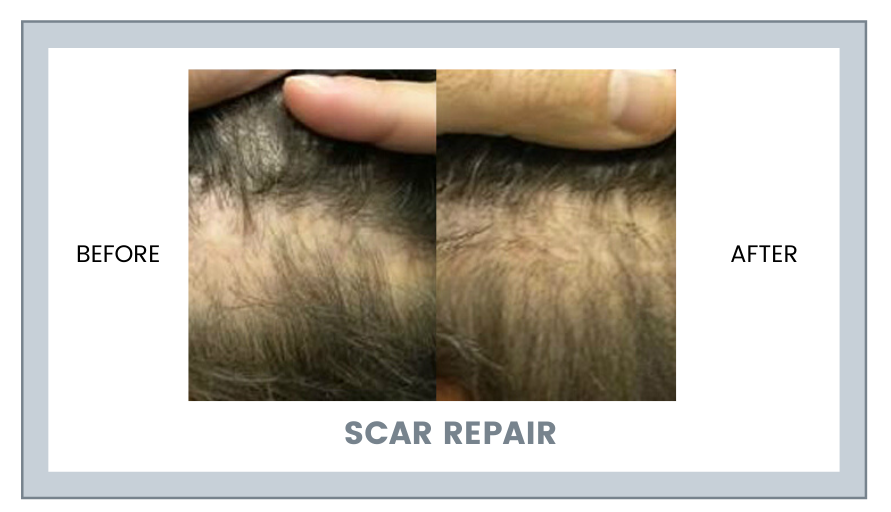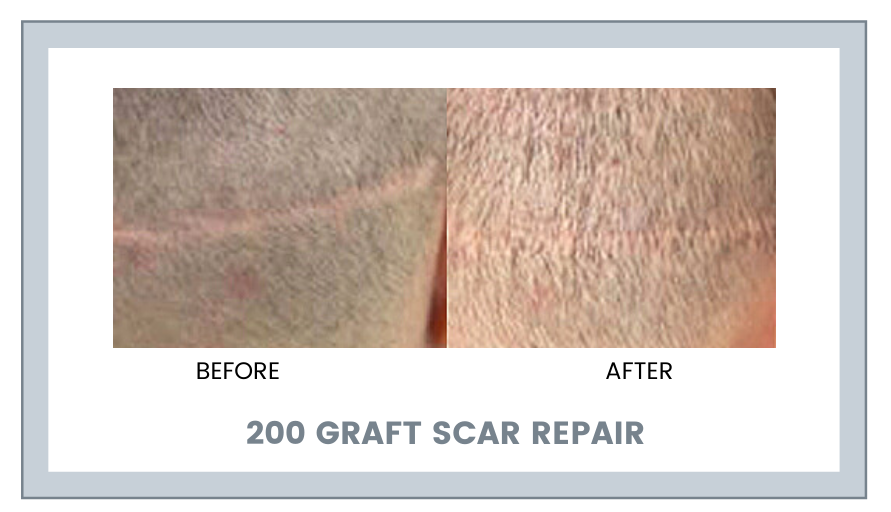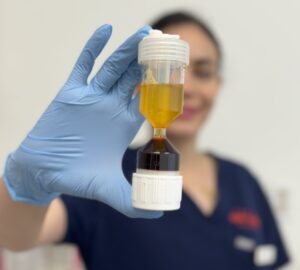At the Toronto Hair Transplant Surgeons, we’ve come across a fair number of patients who are looking for help to reduce scarring from hair replacement surgeries conducted at other clinics.
Most notably, patients who have undergone a FUT or strip procedure and have found themselves dissatisfied or self-conscious about the scar they were left with.
Finding a skilled surgeon to help with these repairs is important because this is not something you want to have to deal with repeatedly. Here’s what we want you to know about closure techniques we use and how we address scar repair or revisions.
TRICHOPHYTIC CLOSURE WORKS WELL WITH STRIP INCISION HAIR TRANSPLANTS
For strip incision hair transplants, the use of trichophytic closure minimizes the appearance of a scar in the donor area. This is done by cutting off the top of one wound edge and suturing it so that the hair from that edge grows through the scar. Either wound edge can be trimmed in the technique, but removing part of the upper edge is most common.
Our very own Dr Jones used this technique for his own hair transplant with incredible results. He added this entry to his Blog on August 1, 2006:
Trichophytic closure works!! Hair growing in my scar!
When a strip of hair is taken from a donor area in order to be transplanted in areas of thinning or non-existent hair, a fine linear scar may remain. Surgeons minimize the risk of a visible scar in various ways. Trichophytic Closure is a way of closing the wound of the donor area that causes hair to grow in that area by suturing the wound edge to the scar.
SCAR REPAIR HAIR RESTORATION TECHNIQUE
Depending on the type of hair restoration technique performed, the physician’s experience, and the amount of tissue removed, scar results will vary. Some scars are small and easy to hide, while others may be in need of additional scar repair.
After multiple procedures, wide scars can become visible and unsightly, needing either revision or planting with follicular unit excision (FUE).
In terms of technique, strip incisions leave recognizably different scars than follicular unit excisions. Strip incision techniques will leave a linear scar on the scalp, while follicular unit excision leaves 1mm, round-shaped scars around the donor areas. Scars caused by follicular unit excision are less visible than scars caused by other techniques. Visibility of scars also depends on the patient’s hair length and the experience of the physician.
There are two methods of scar repair used on patients: scar revision with suture and placement of follicular unit excision into the scar.
1. Scar Revision with Suture
This is a method of scar repair that involves improving the appearance of the scar. If there is not too much tension on the scar, an attempt can be made at excising the scar and resuturing it. Every effort must be made to minimize any tension on the scar as “stretch back” or reopening will occur.
Generally, there is a 90% chance that the scar will improve with scar revision. Other possibilities include a 9% chance that the scar will remain the same and a small 1% chance that the scar will be worse.
2. Placement of FUE Into Scar
This has become a very popular means of scar repair. It involves removing hair from the body or head and placing it into the scar tissue at the back of the head. Usually, 50% to 90% of the grafts grow in scars, making the scarred areas of the scalp much less visible.
Scar Repair Using ACell
A biotechnology company called ACell has created a product that regenerates the skin of scars with normal hair follicles. The product is a basement membrane that allows for epithelial cell growth, or more simply skin regeneration. The raw concept is to stimulate the bodies’ natural processes to re-grow damaged skin. The idea is that since this regeneration is natural it won’t be rejected by the body. They also wanted it to be absorbable so there’s no trace and completely natural to the patient’s body.
ACell is a product that has been used in Veterinary medicine for years. It caught the interest of our doctors because it not only regenerates skin but regenerates skin with normal hair follicles. Further, Acell has been approved for wound care in humans, and in patients where it has been used, the hair follicles regenerate as well as the skin.
For some additional insight into our work here are the Toronto Hair Transplant Surgeons, please see some of our before and after photos below or visit our gallery for more examples of our work:












